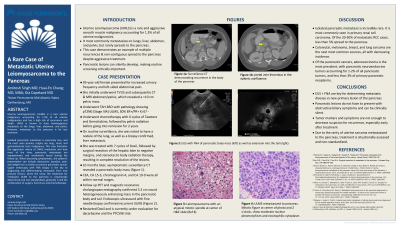Back


Poster Session A - Sunday Afternoon
Category: Biliary/Pancreas
A0076 - A Rare Case of Metastatic Uterine Leiomyosarcoma to the Pancreas
Sunday, October 23, 2022
5:00 PM – 7:00 PM ET
Location: Crown Ballroom

Has Audio

Amitosh K. Singh, MD
Kaiser Permanente Mid-Atlantic States Internal Medicine Residency Program
Gaithersburg, MD
Presenting Author(s)
Amitosh K. Singh, MD1, Huai-En R. Chang, MD, MPH, MBA1, Katrina Hsieh, DO1, Dia Copeland, MD, MBA2
1Kaiser Permanente Mid-Atlantic States Internal Medicine Residency Program, Gaithersburg, MD; 2Kaiser Permanente Mid-Atlantic States, Largo, MD
Introduction: Uterine leiomyosarcoma (ULMS) is a rare uterine malignancy accounting for 1.3% of all uterine malignancies and has a high risk of recurrence and death. UMLS is known to have hematogenous metastasis to the lungs, liver, abdomen, and pelvis, but metastasis to the pancreas is far less common.
Case Description/Methods: A 39-year-old female presented to the clinic with urinary frequency and left-sided pelvic pain. She was later diagnosed with a 10 x 8 x 12 cm solid pelvis mass, without signs of metastasis on CT and MRI and underwent a total abdominal hysterectomy with bilateral salpingo-oophorectomy. Pathology confirmed the diagnosis of ULMS without identifiable lymphovascular invasion. Estrogen receptor (ER) and progesterone receptor (PR) were positive 50% and 50%, respectively, with a negative Ki-67 marker. She subsequently received 6 cycles of Docetaxel and gemcitabine followed by pelvic radiation.
She remained asymptomatic for 2 years but later had a recurrence with the right lower lung and liver on surveillance CT. Liver biopsy confirmed metastatic ULMS with ER 30% and PR 10%. She subsequently received 7 cycles of Doxorubicin, which showed a response with an interval decrease in mass size. She underwent liver nodule resection and stereotactic body radiation therapy to the right lung lobe. Follow-up surveillance CT chest, abdomen, & pelvis showed resolution of both lesions.
However, a repeat scan 5 months later revealed a 2.8 x 2.7 cm hypoenhancing pancreatic body mass which was confirmed to be recurrent ULMS by the endoscopic ultrasound with a fine needle aspiration (EUS-FNA) despite being asymptomatic. CEA, CA 15-3, chromogranin A, and CA 19-9 were within normal limits. She was started on Doxorubicin and is currently under evaluation for dacarbazine and the PTC596 trial.
Discussion: Pancreatic metastasis is extremely rare, and the most seen primary origins are lung, renal, and gastrointestinal tract malignancies. This case illustrates the aggressive nature of UMLS metastasis and how, pancreatic metastases are asymptomatic and incidentally found during the follow-up. When becoming symptomatic, the presentation such as obstructive jaundice, pain, and weight loss is similar to the primary pancreatic cancer. EUS-FNA biopsy is the key to diagnosing and differentiating metastatic from new primary lesions. Given the rarity, the treatment for metastatic ULMS to the pancreas is situationally determined and non-standardized, generally is still the combination of surgery, hormonal, and chemotherapy.

Disclosures:
Amitosh K. Singh, MD1, Huai-En R. Chang, MD, MPH, MBA1, Katrina Hsieh, DO1, Dia Copeland, MD, MBA2. A0076 - A Rare Case of Metastatic Uterine Leiomyosarcoma to the Pancreas, ACG 2022 Annual Scientific Meeting Abstracts. Charlotte, NC: American College of Gastroenterology.
1Kaiser Permanente Mid-Atlantic States Internal Medicine Residency Program, Gaithersburg, MD; 2Kaiser Permanente Mid-Atlantic States, Largo, MD
Introduction: Uterine leiomyosarcoma (ULMS) is a rare uterine malignancy accounting for 1.3% of all uterine malignancies and has a high risk of recurrence and death. UMLS is known to have hematogenous metastasis to the lungs, liver, abdomen, and pelvis, but metastasis to the pancreas is far less common.
Case Description/Methods: A 39-year-old female presented to the clinic with urinary frequency and left-sided pelvic pain. She was later diagnosed with a 10 x 8 x 12 cm solid pelvis mass, without signs of metastasis on CT and MRI and underwent a total abdominal hysterectomy with bilateral salpingo-oophorectomy. Pathology confirmed the diagnosis of ULMS without identifiable lymphovascular invasion. Estrogen receptor (ER) and progesterone receptor (PR) were positive 50% and 50%, respectively, with a negative Ki-67 marker. She subsequently received 6 cycles of Docetaxel and gemcitabine followed by pelvic radiation.
She remained asymptomatic for 2 years but later had a recurrence with the right lower lung and liver on surveillance CT. Liver biopsy confirmed metastatic ULMS with ER 30% and PR 10%. She subsequently received 7 cycles of Doxorubicin, which showed a response with an interval decrease in mass size. She underwent liver nodule resection and stereotactic body radiation therapy to the right lung lobe. Follow-up surveillance CT chest, abdomen, & pelvis showed resolution of both lesions.
However, a repeat scan 5 months later revealed a 2.8 x 2.7 cm hypoenhancing pancreatic body mass which was confirmed to be recurrent ULMS by the endoscopic ultrasound with a fine needle aspiration (EUS-FNA) despite being asymptomatic. CEA, CA 15-3, chromogranin A, and CA 19-9 were within normal limits. She was started on Doxorubicin and is currently under evaluation for dacarbazine and the PTC596 trial.
Discussion: Pancreatic metastasis is extremely rare, and the most seen primary origins are lung, renal, and gastrointestinal tract malignancies. This case illustrates the aggressive nature of UMLS metastasis and how, pancreatic metastases are asymptomatic and incidentally found during the follow-up. When becoming symptomatic, the presentation such as obstructive jaundice, pain, and weight loss is similar to the primary pancreatic cancer. EUS-FNA biopsy is the key to diagnosing and differentiating metastatic from new primary lesions. Given the rarity, the treatment for metastatic ULMS to the pancreas is situationally determined and non-standardized, generally is still the combination of surgery, hormonal, and chemotherapy.

Figure: Figure 1
Disclosures:
Amitosh Singh indicated no relevant financial relationships.
Huai-En Chang indicated no relevant financial relationships.
Katrina Hsieh indicated no relevant financial relationships.
Dia Copeland indicated no relevant financial relationships.
Amitosh K. Singh, MD1, Huai-En R. Chang, MD, MPH, MBA1, Katrina Hsieh, DO1, Dia Copeland, MD, MBA2. A0076 - A Rare Case of Metastatic Uterine Leiomyosarcoma to the Pancreas, ACG 2022 Annual Scientific Meeting Abstracts. Charlotte, NC: American College of Gastroenterology.
